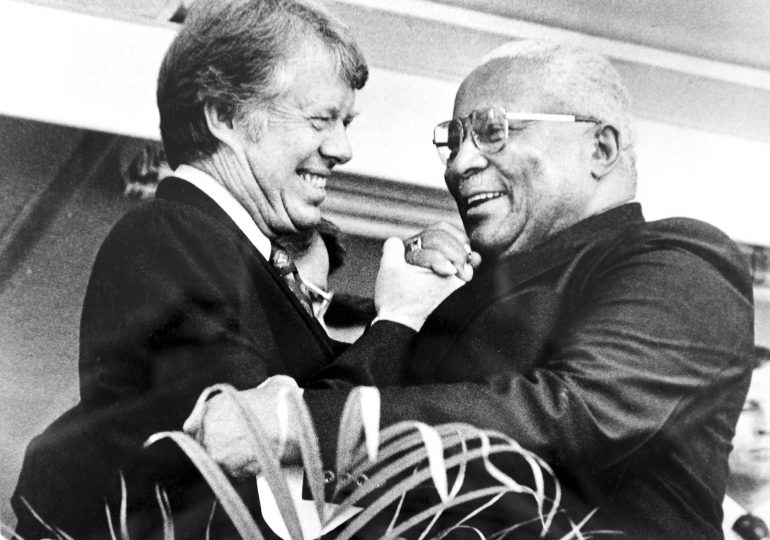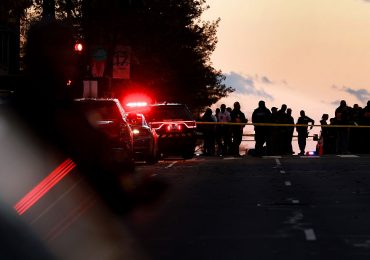The career of Jimmy Carter, the U.S. President who died on Dec. 29 at age 100, will be remembered for many things: his peanut-farming background, his speedy rise to political fame and fall after one term, his handling — or mishandling — of the energy crisis and the Iran hostage crisis.
Another achievement, from early in his career, may be less well known, but is just as worthy of remembrance.
[time-brightcove not-tgx=”true”]
The mid-1970s, when Carter became a national public figure, was a time of transition, full of the aftershocks of the progress and devastation that had characterized the previous decade, not least in the arena of the civil rights movement. Carter was a Georgian of many generations, whose farming family’s presence in the South predated the United States itself. He had no trouble establishing his Southern credentials, but he also differed from many of his neighbors when it came to integration and other racial issues.
As TIME recounted in a 1976 profile of the then-candidate, his mother, known as “Miss Lillian,” was a formidable presence in her four children’s lives and encouraged them to have compassion for all people, regardless of race—despite any judgment from neighbors steeped in prejudice.
Read More: Jimmy Carter Was More Successful Than He Got Credit For
In 1966, Carter, the oldest of those four children, lost the Georgia gubernatorial primary to a segregationist. Four years later, he managed to win the support of some prominent segregationists in the state by ceding ground to them: He said that he would allow George Wallace, perhaps the most famous of them all, to speak at the state house if he won. But, after winning the office, Carter made it clear that he hadn’t totally abandoned his principles, as TIME recounted in the 1976 story:
“Elected by a landslide vote, Carter appeared to be a changed man in office—leading to accusations that he had misled the voters. In his inaugural address, he proclaimed: “The time for racial discrimination is over. No poor rural white or black person should ever have to bear the additional burden of being deprived of the opportunity of an education, a job or simple justice.” [Segregationist former Governor Lester] Maddox cried foul and started sniping at Carter. He has never stopped. He even pursued Carter to New Hampshire last month to denounce him as “the McGovern of ‘76” and “the Dr. Jekyll and Mr. Hyde of ‘76.”
Unlike [former governor Carl] Sanders, Carter appointed blacks to posts at every level of state government. (Sanders today concedes: “Carter is far more liberal than I ever was.”) He set up a biracial “disorder unit” of various experts to mediate clashes between blacks and whites. Since Georgia did not have federal referees to enforce the Voting Rights Act of 1965, Carter deputized all the high school principals in the state as registrars so that they could sign up voters at school. He overhauled the state prison and mental hospitals, which contained a high proportion of blacks. He set up a system of drug treatment and day care centers.
Carter appealed to blacks perhaps even more strongly by making certain symbolic gestures. When black legislators had a party in their part of town, they sent a routine invitation to the Governor. Much to their surprise, he showed up, and word spread quickly that the Governor was eating chitlins with the brothers. In the state capitol in 1974, Carter placed a portrait of Martin Luther King Jr. on a wall amid pictures of other Georgia notables, while an integrated audience sang We Shall Overcome. Many blacks who did not vote for Carter swung over to his support. Now his presidential drive is endorsed by men as disparate as Martin Luther King Sr. and Henry Aaron.“
Sure enough, in the presidential primaries that year, again and again Carter carried the African American vote. As TIME remarked, “The phenomenon of blacks backing a Southern white reared in the Georgia backwoods is one of the most intriguing aspects of the campaign to date.” Though support for Carter was driven by his record of conciliation, which he often couched in spiritual language, it was also helped by the fact that George Wallace was one of his main opponents.
That choice helped many voters overlook the moments when Carter’s civil rights record could be called into doubt, such as his wavering support for busing to integrate schools. During the presidential campaign, Carter also had to apologize for what he called a “careless” choice of words in defense of his stance in opposition to legislating the integration of neighborhoods. (His discussion of the “purity” of communities called to mind, for many, some of history’s worst examples of prejudice.) But as TIME noted when naming him 1976’s Man of the Year, his success “destroyed forever the hopes of Alabama’s George Wallace of rising to national power —a possibility already dimmed by the bullet of a would-be assassin. By showing that a nonracist Southerner could win a major party nomination, Carter gave new pride to his region and went far to heal ancient wounds.”
After his Presidency, following a period of relative seclusion in his Georgia hometown, he returned to public life and brought his ideals with him, devoting his life to bettering the world. In 1989, TIME declared that he “may be the best former President America has ever had”; in 2002, he was awarded a Nobel Peace Price.
Not that those who followed his career would be surprised. Asked by TIME, shortly before he came into the White House, whether all the work he had to do was an overwhelming prospect, Jimmy Carter showed the same humble dedication that would carry him through the decades that followed: “Yes,” he said, “but not so much that I would want someone else to do it.”
Read an interview with Jimmy Carter on the eve of his inauguration: “I Look Forward to the Job”
Read Jimmy Carter’s “Man of the Year” cover story from 1977: I’m Jimmy Carter, and…
Leave a comment








